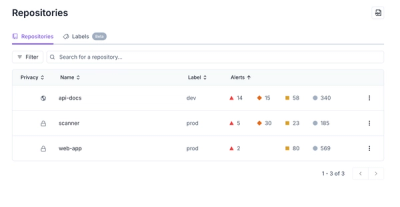
Product
Redesigned Repositories Page: A Faster Way to Prioritize Security Risk
Our redesigned Repositories page adds alert severity, filtering, and tabs for faster triage and clearer insights across all your projects.
@nodeart/async-buffer
Advanced tools
AsyncBuffer is used for async tasks accumulation and calling them sequentially after buffer limit will be exceeded. By default AsyncBuffer starts its operation automatically just after tasks limit is reached.
AsyncBuffer
AsyncBuffer is used for async tasks accumulation and calling them sequentially after buffer limit will be exceeded. By default AsyncBuffer starts its operation automatically just after tasks limit is reached. AsyncBuffer can be used in browser as well as in Node.
For example one can use this package to work with database. Imagine you can use http server working and on each request you must push some info to database. Instead of doing it each time you can push task to buffer and writing to database will start after limit is exceeded.
Each task is provided with callback as first parameter. It must be called to proceed operation.
You can optionally pass a parameter to the callback and it will be treated as a result of the task and stored inside results array.
Second parameter in task is result if previous task (if no parameter provided null will be pushed to results array).
Default stack capacity is 50 tasks.
Basic usage:
let buffer = new AsyncBuffer(4),
task = function(cb) {
setTimeout(function () {
console.log(`I was called`);
cb('result');
}, 1000)
};
buffer.on('drain', function (results) {
console.log('I was drained', results);
}).push(task);
You can switch off auto execution by setting second parameter in constructor to false and start task execution manually.
Also push method supports multiple parameters, so you can provide several tasks like so:
let buffer = new AsyncBuffer(5, false),
task = function(cb) {
setTimeout(function () {
console.log(`I was called`);
cb('result');
}, 1000)
};
buffer.on('stack_filled', function () {
console.log('Stack is filled');
buffer.drainBuffer();
}).push(task, task, task, task, task);
or by using of apply
buffer.push(buffer, [task, task, task]);
Also you there is two events that are used to notify about starting and ending of operation ('start' and 'drain' respectively).
'drain' event callback is provided with results of operation as a first parameter.
buffer.on('start', () => console.log('Execution is started'))
.on('drain', results => console.log('I was drained', results),
results => console.log('Really drained', results));
Also you can use drainBufferParallel method to replace sequential execution with parallel.
After execution chunk_done event will be emitted and if no tasks were added during process drain event will be emitted as well.
Example:
buffer.on('stop', () => console.log('stop'))
.push(task, task, task, task, task)
.drainBuffer()
.once('drain', res => { // wait till all sequential tasks will be executed;
console.log('drained', res);
buffer.push(task, task, task, task, task)
.drainBufferParallel() // execute these tasks parallel;
.push(task, task, task, task, task) // add another chunk;
.stopExecution() // stop execution (only first five tasks will be executed);
.on('chunk_done', res => console.log('chunk_done', res)); // get results of first five tasks;
});
If you need to:
false use drainBuffer function.clearTasksStack function.stopExecution function. Buffer will handle all tasks that was executed, but will not trigger next. Example:buffer.on('stop', function(currentResults) {
console.log(`Execution has been stopped. Here is results ${currentResults}`);
//continue execution
buffer.drainBuffer();
})
monkeyPatch(function (exit) {
return function () {
buffer.on('drain', () => exit())
.drainBuffer();
}
});
FAQs
AsyncBuffer is used for async tasks accumulation and calling them sequentially after buffer limit will be exceeded. By default AsyncBuffer starts its operation automatically just after tasks limit is reached.
The npm package @nodeart/async-buffer receives a total of 2 weekly downloads. As such, @nodeart/async-buffer popularity was classified as not popular.
We found that @nodeart/async-buffer demonstrated a not healthy version release cadence and project activity because the last version was released a year ago. It has 1 open source maintainer collaborating on the project.
Did you know?

Socket for GitHub automatically highlights issues in each pull request and monitors the health of all your open source dependencies. Discover the contents of your packages and block harmful activity before you install or update your dependencies.

Product
Our redesigned Repositories page adds alert severity, filtering, and tabs for faster triage and clearer insights across all your projects.

Security News
Slopsquatting is a new supply chain threat where AI-assisted code generators recommend hallucinated packages that attackers register and weaponize.

Security News
Multiple deserialization flaws in PyTorch Lightning could allow remote code execution when loading untrusted model files, affecting versions up to 2.4.0.